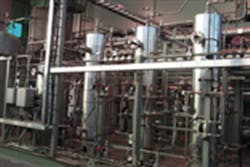An end to scrap tires? TDP may be the greatest innovation of the 21st century
There is nothing pretentious about the machine itself. There are nondescript reactors and tanks, even grinders, all connected by what seems like miles of tubing. There are valves at almost every turn.
It looks like a waste treatment plant of sorts, and it is -- the ultimate waste treatment plant.
If everything goes as planned, the thermal depolymerization process (TDP) plant in Carthage, Mo., soon will be up and running, heating and pressurizing almost any carbon-based material -- from hazardous wastes to turkey guts -- into oil and other byproducts.
Scrap tires could be turned into reusable oil, gas, carbon and metal, with almost no waste of materials and no polluting emissions.
This isn't pyrolysis (see sidebar). This is an innovative process that on the surface looks to be both energy-efficient and affordable. It could not only solve the world's scrap tire problem, but also give us solutions to diminishing oil reserves and global warming. Investors, including Long Island City, N.Y.-based Max Finkelstein Inc., are putting a lot of money behind making TDP plants a reality.
The man promoting the cutting edge technology is Brian Appel, chairman and CEO of Changing World Technologies. Appel didn't invent the process, but became familiar with the work of its inventor, Paul Baskis, and purchased the rights to the patents.
One of the keys to TDP is the way it turns the old-school philosophy of eliminating water from the waste-to-oil process on its head. Evaporating water out of the operation takes a lot of energy; instead, TDP adds it to the finely ground up waste to create a "slurry" mixture, which is then heated and pressurized. "It is easier to heat a liquid than a solid," says Appel. The result? The water acts as a conductor, and heats the slurry more evenly. It also keeps temperatures from rising above 900 degrees Fahrenheit.
"Tires require a particle size reduction step that includes a pre-breaker, shredder and grinder, done in an aqueous environment, to
produce a 'pumpable' slurry," says Appel. "Tires are heated and pressurized and pumped continuously through heat exchangers and reactors.
"A series of separation systems follow to remove any water, metal, inorganic and carbon black that make up the slurry. The tire gel is then further processed in a second-stage reactor, where the material is further broken down into fuel gas (which is used for process heat), tire-derived hydrocarbon oil and fixed carbon."
It takes only 15 units of energy, or btus, to create 100 units of energy in the form of oil, gas and other materials, according to Appel.
"Energy efficiency can be calculated in several ways. The energy efficiency used is the energy in the combustible products that leave the
plant divided by the total energy input. The input includes the energy in the tires, the electric power and any natural gas that is used in the process. The 15% operates the plant and, of course, pumps, motors and heaters."
He says fuel blenders, power companies or refineries can use the oil produced from tires. "The oil product could be used immediately in any diesel engine, including those used in cars or trucks."
The oil is carbon-neutral, which means there is no new net increase of carbon or carbon dioxide to the earth's atmosphere. "Tires already on the earth's surface are recycled in the thermal process. This means much less fossil fuel needs to be dug up from beneath the ground."
In addition to recycling, the process separates carbon black from the tire slurry in the second stage reactor. "This fixed carbon is from the heavy oil originally used to produce tires," says Appel.
Success could lead to thousands of plants around the world. A number of magazines, including Discover and the Massachusetts Institute of Technology's Technology Review, already have written articles supporting the viability of TDP. But until the scientific community subjects the oil and other materials to critical analysis, skeptics will abound.
TDP vs. pyrolysis
Like the thermal depolymerization process (TDP), pyrolysis also converts organic based wastes to a form of fuel gas and/or hydrocarbon liquids that can be used as fuels or feedstock. But that's where the similarities end.
Pyrolysis produces a gas mixture containing hydrogen, methane and carbon monoxide; an oily liquid byproduct also may be produced. It is more capital intensive and less efficient than TDP. Some of the byproducts have little or no value, and the oil produced is generally high in tar and asphalt components with low viscosity, in contrast to TDP oil, which has had the impurities filtered out of it.
In addition, the pyrolysis process suffers from poor heat transfer. TDP incorporates water into its system to heat materials more evenly and efficiently.
About the Author

Bob Ulrich
Bob Ulrich was named Modern Tire Dealer editor in August 2000 and retired in January 2020. He joined the magazine in 1985 as assistant editor, and had been responsible for gathering statistical information for MTD's "Facts Issue" since 1993. He won numerous awards for editorial and feature writing, including five gold medals from the International Automotive Media Association. Bob earned a B.A. in English literature from Ohio Northern University and has a law degree from the University of Akron.
